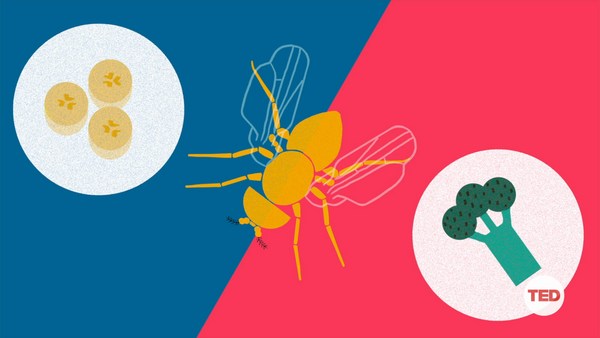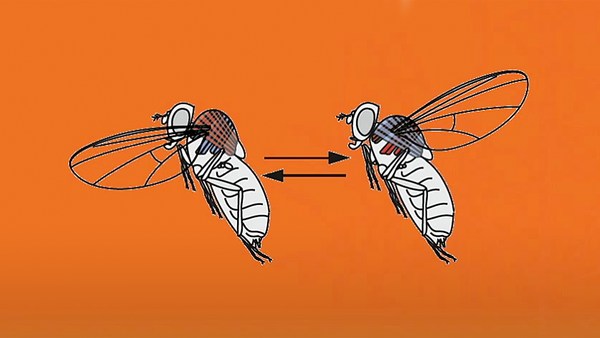Greg Gage: If I asked you to think of a ferocious killer animal, you'd probably think of a lion, and for all the wonderful predatory skills that a lion has, it still only has about a 20 percent success rate at catching a meal. Now, one of the most successful hunters in the entire animal kingdom is surprising: the dragonfly. Now, dragonflies are killer flies, and when they see a smaller fly, they have about a 97 percent chance of catching it for a meal. And this is in mid-flight. But how can such a small insect be so precise? In this episode, we're going to see how the dragonfly's brain is highly specialized to be a deadly killer.
[DIY Neuroscience]
So what makes the dragonfly one of the most successful predators in the animal kingdom? One, it's the eyes. It has near 360-degree vision. Two, the wings. With individual control of its wings, the dragonfly can move precisely in any direction. But the real secret to the dragonfly's success is how its brain coordinates this complex information between the eyes and the wings and turns hunting into a simple reflex. To study this, Jaimie's been spending a lot of time socializing with dragonflies. What do you need to do your experiments?
Jaimie Spahr: First of all, you need dragonflies.
Oliver: I have a mesh cage to catch the dragonflies.
JS: The more I worked with them, the more terrified I got of them. They're actually very scary, especially under a microscope. They have really sharp mandibles, are generally pretty aggressive, which I guess also helps them to be really good predators.
GG: In order to learn what's going on inside the dragonfly's brain when it sees a prey, we're going to eavesdrop in on a conversation between the eyes and the wings, and to do that, we need to anesthetize the dragonfly on ice and make sure we protect its wings so that we can release it afterwards. Now, the dragonfly's brain is made up of specialized cells called neurons and these neurons are what allow the dragonfly to see and move so quickly. The individual neurons form circuits by connecting to each other via long, tiny threads called axons and the neurons communicate over these axons using electricity. In the dragonfly, we're going to place little metal wires, or electrodes, along the axon tracks, and this is what's really cool. In the dragonfly, there's only 16 neurons; that's eight per eye that tell the wings exactly where the target is. We've placed the electrodes so that we can record from these neurons that connect the eyes to the wings. Whenever a message is being passed from the eye to the wing, our electrode intercepts that conversation in the form of an electrical current, and it amplifies it. Now, we can both hear it and see it in the form of a spike, which we also call an action potential.
Now let's listen in. Right now, we have the dragonfly flipped upside down, so he's looking down towards the ground. We're going to take a prey, or what we sometimes call a target. In this case, the target's going to be a fake fly. We're going to move it into the dragonfly's sights.
(Buzzing)
Oh! Oh, look at that. Look at that, but it's only in one direction. Oh, yes! You don't see any spikes when I go forward, but they're all when I come back.
In our experiments, we were able to see that the neurons of the dragonfly fired when we moved the target in one direction but not the other.
Now, why is that? Remember when I said that the dragonfly had near 360-degree vision. Well, there's a section of the eye called the fovea and this is the part that has the sharpest visual acuity, and you can think of it as its crosshairs. Remember when I told you the dragonfly had individual precise control of its wings? When a dragonfly sees its prey, it trains its crosshairs on it and along its axons it sends messages only to the neurons that control the parts of the wings that are needed to keep that dragonfly on target. So if the prey is on the left of the dragonfly, only the neurons that are tugging the wings to the left are fired. And if the prey moves to the right of the dragonfly, those same neurons are not needed, so they're going to remain quiet. And the dragonfly speeds toward the prey at a fixed angle that's communicated by this crosshairs to the wings, and then boom, dinner.
Now, all this happens in a split second, and it's effortless for the dragonfly. It's almost like a reflex. And this whole incredibly efficient process is called fixation.
But there's one more story to this process. We saw how the neurons respond to movements, but how does the dragonfly know that something really is prey? This is where size matters.
Let's show the dragonfly a series of dots. Oh, yeah!
JS: Yeah, it prefers that one.
GG: Out of all the sizes, we found that the dragonfly responded to smaller targets over larger ones. In other words, the dragonfly was programmed to go after smaller flies versus something much larger, like a bird. And as soon as it recognizes something as prey, that poor little fly only has seconds to live. Today we got to see how the dragonfly's brain works to make it a very efficient killer. And let's be thankful that we didn't live 300 million years ago when dragonflies were the size of cats.





